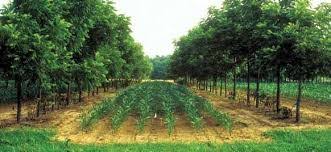Source: naturesorganichaven.com
Published: March 2, 2017
NOTE: Source Link website has invalid certificate.

According to the Association for Temperate Agrofiorestry, “Agroforestry is a land management system that optimizes the benefits from the biological interactions created when trees and/or shrubs are deliberately combined with crops and/or livestock. There are five basic types of agroforestry practices today in the North America: windbreaks, alley cropping, silvopasture, riparian buffers and forest farming. Within each agroforestry practice, there is a continuum of options available to landowners depending on their own goals (e.g., whether to maximize the production of interplanted crops, animal forage, or trees).”
Five Basic types of Agroforestry practice
Alley cropping is growing food, forage or specialty crops between rows of trees.
Windbreaks are linear plantings of trees and shrubs designed to enhance crop production, protect people and livestock from wind, and benefit soil and water conservation.
Forest farming is the cultivation of edible, medicinal or decorative specialty crops beneath native or planted woodlands.
Riparian forest buffers are strips of trees, shrubs and grass planted between cropland or pasture and streams and rivers. Buffers protect water quality, reduce erosion and flooding.
Silvopasture is combining forestry and grazing of livestock in a mutually beneficial way.
Benefits of Agroforestry
According to the USDA, here are a few benefits of properly designed agroforestry systems:
- protect crops and forage
- increase crop production
- protect soil and water resources
- conserve energy
- improve ecosystem “richness”
- create additional wildlife habitat
- increase landscape diversity
- They also provide additional farm or ranch products: timber, pulpwood, firewood, posts, fruit, nuts, and fodder to name a few.
- Crops and livestock protected from damaging effects of wind are more productive
